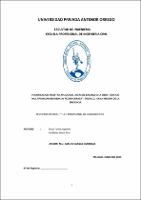| dc.contributor.advisor | Vargas Cardenas, Carlos | |
| dc.contributor.author | Chun Torres, Lizzeths | |
| dc.contributor.author | Sevillano Sierra, Elías | |
| dc.creator | Chun Torres, Lizzeths | |
| dc.date.accessioned | 2015-10-06T16:44:27Z | |
| dc.date.available | 2015-10-06T16:44:27Z | |
| dc.date.issued | 2015 | |
| dc.identifier.uri | https://hdl.handle.net/20.500.12759/1145 | |
| dc.description.abstract | La presente tesis realiza una planificación maestra empleando el método de líneas de balance con el fin de demostrar si es verdad que este método aumenta significativamente la productividad y la eficiencia de la obra.
Estos indicadores fueron empleados y comparados para mostrar la relación y diferencia entre el método tradicional y el método utilizando líneas de balance, estos indicadores permiten observar si la hipótesis planteada fue exacta o no.
En el primer capítulo se tendrá una pequeña introducción del tema a tratar con los datos que fueron necesarios para iniciar con todo esto. En el segundo capítulo se habla de la reseña historia de lean construcción, como inicio y como fue avanzando en el tiempo, siendo cada vez más útil y ventajosa para el rubro de la construcción. En el tercer capítulo se hablará del método de líneas de balance, como surgió, en que obras fueron empleadas, cuáles fueron sus resultados y se pondrá en práctica el método con un ejemplo muy básico con ayuda del programa Excel. Terminando, en el cuarto capítulo se observa la aplicación del método líneas de balance en la programación maestra de la obra “Edificio multifamiliar Pedro Urraca”.
Finalmente en los capítulos siguientes quinto, sexto y sétimo se hablará de los resultados, se discutirá y modificará algunos datos y se determinará qué camino es el más productivo y eficiente, con estos últimos datos se finalizará con las conclusiones. | es_PE |
| dc.description.abstract | This thesis makes a master planning using the method of lines of balance to
show if it is true that this method significantly increases the productivity and
efficiency of the work.
These indicators were employed and compared to show the relationship and
difference between the traditional method and the method using lines of
balance, these indicators allow us to observe whether the hypothesis was
correct or not.
In the first chapter, we will have a brief introduction of the topic to deal with
data that were necessary to start with this. In the second chapter discusses the
history of lean construction review, as start and as it progressed over time,
becoming more useful and advantageous for the construction industry. In the
third chapter discusses the method of lines of balance, as emerged in which
works were used, what were your results and will implement the method with a
very basic example using the Excel program. Ending in the fourth chapter
observe the application of the method balance lines in master scheduling of the
work “Multifamily building Pedro Urraca“.
Finally in the following chapters fifth, sixth and seventh discuss the results,
discuss and modify some data and see which path is the most productive and
efficient with recent data will finish with conclusions. | en_US |
| dc.description.uri | Tesis | es_PE |
| dc.format | application/pdf | es_PE |
| dc.language.iso | spa | es_PE |
| dc.publisher | Universidad Privada Antenor Orrego - UPAO | es_PE |
| dc.rights | info:eu-repo/semantics/openAccess | es_PE |
| dc.source | Universidad Privada Antenor Orrego | es_PE |
| dc.source | Repositorio Institucional - UPAO | es_PE |
| dc.subject | Líneas de balance obra | es_PE |
| dc.subject | Edificio multifamiliar | es_PE |
| dc.subject | Residencial Pedro Urraca | es_PE |
| dc.title | Planificación maestra aplicando líneas de balance a la obra ‘Edificio Multifamiliar Residencial Pedro Urraca’ - Trujillo, en la mejora de la eficiencia | es_PE |
| dc.type | info:eu-repo/semantics/bachelorThesis | es_PE |
| thesis.degree.level | Título Profesional | es_PE |
| thesis.degree.grantor | Universidad Privada Antenor Orrego. Facultad de Ingeniería | es_PE |
| thesis.degree.name | Ingeniero Civil | es_PE |
| thesis.degree.discipline | Ingeniería Civil | es_PE |

